Nikolas Cruz sentencing trial: Key revelations about Parkland shooter and his massacre
A jury recommended Cruz serve a life sentence for carrying out one of the worst school shootings in American history
Parkland shooter Nikolas Cruz was sentenced to life in prison by a jury after months of chilling testimony and just one day of deliberation.
On Valentine’s Day 2018, Cruz traveled to Marjory Stoneman Douglas High School armed with an AR-15-style rifle.
There, the then-19-year-old stalked all three floors of the freshman building, shooting and killing 17 students and staff members.
Cruz, now 23, pleaded guilty in October 2021 to 17 counts of murder and 17 counts of attempted murder.
The jury was tasked with deciding whether to hand him the death penalty or to sentence him to life in prison without the possibility of parole.
On 13 October, jurors alerted the court that they had reached a verdict, recommending life in prison for the killer.
Prosecutors spent three weeks presenting graphic details of how Cruz plotted and carried out the attack, footage of him calmly going to a nearby Subway and McDonald’s in the immediate aftermath and heartbreaking testimony from the victims’ families.
The defence then spent 11 days presenting its case, seeking to show that Cruz suffered from behavioural and developmental issues and endured a troubled upbringing – and did not receive the appropriate help he needed.
Here are key revelations from the lengthy trial:
Graphic surveillance footage shows murderous rampage
At the start of the sentencing trial, graphic surveillance footage was played in court of Cruz carrying out his murderous rampage.
The video, taken from security cameras inside Marjory Stoneman Douglas on Valentine’s Day 2018, showed Cruz stalking the corridors of the three-storey freshman building, shooting students and staff members.
Prosecutors said it showed Cruz shooting some victims multiple times at point-blank range and returning to wounded victims to kill them with a second hail of bullets.
Jurors were seen putting their hands to their faces as they watched the 15-minute recording, which has no sound. The gallery – where the victims’ families sat – were not able to see it.

Horrifying cellphone footage captured by a terrified student was also shown in court.
In it, shots were heard ringing out and a voice was heard saying: “Someone help me.”
Cruz warned student ‘things were about to get bad’
Several survivors of the shooting took the stand to relive their harrowing experiences that day, with one student recounting how Cruz warned him “things were about to get bad” moments before the massacre began.
Christopher McKenna, a freshman student at the time, testified that he bumped into Cruz in the stairwell of the freshman building on his way to the restroom. Cruz was holding his semi-automatic rifle.
“He said get out of here. Things are about to get bad,” Mr McKenna recalled.
Mr McKenna ran out of the building and told school football coach Aaron Feis what had happened.
Mr Feis took Mr McKenna away from the scene and ran towards the building in the direction of the shooting, where he became one of Cruz’s first victims.
The court also heard from students William Olson, Alex Dworet and Kheshava Manhapuram – who were all sat in the same English class that Mr McKenna had left when Cruz shot through the walls and door. They were all shot but survived.
In traumatic testimony, the survivors recounted seeing their friend Alex Schacter slumped over his desk after being fatally struck by bullets. Alaina Petty and Alyssa Alhadeff, both 14, also died in the classroom.
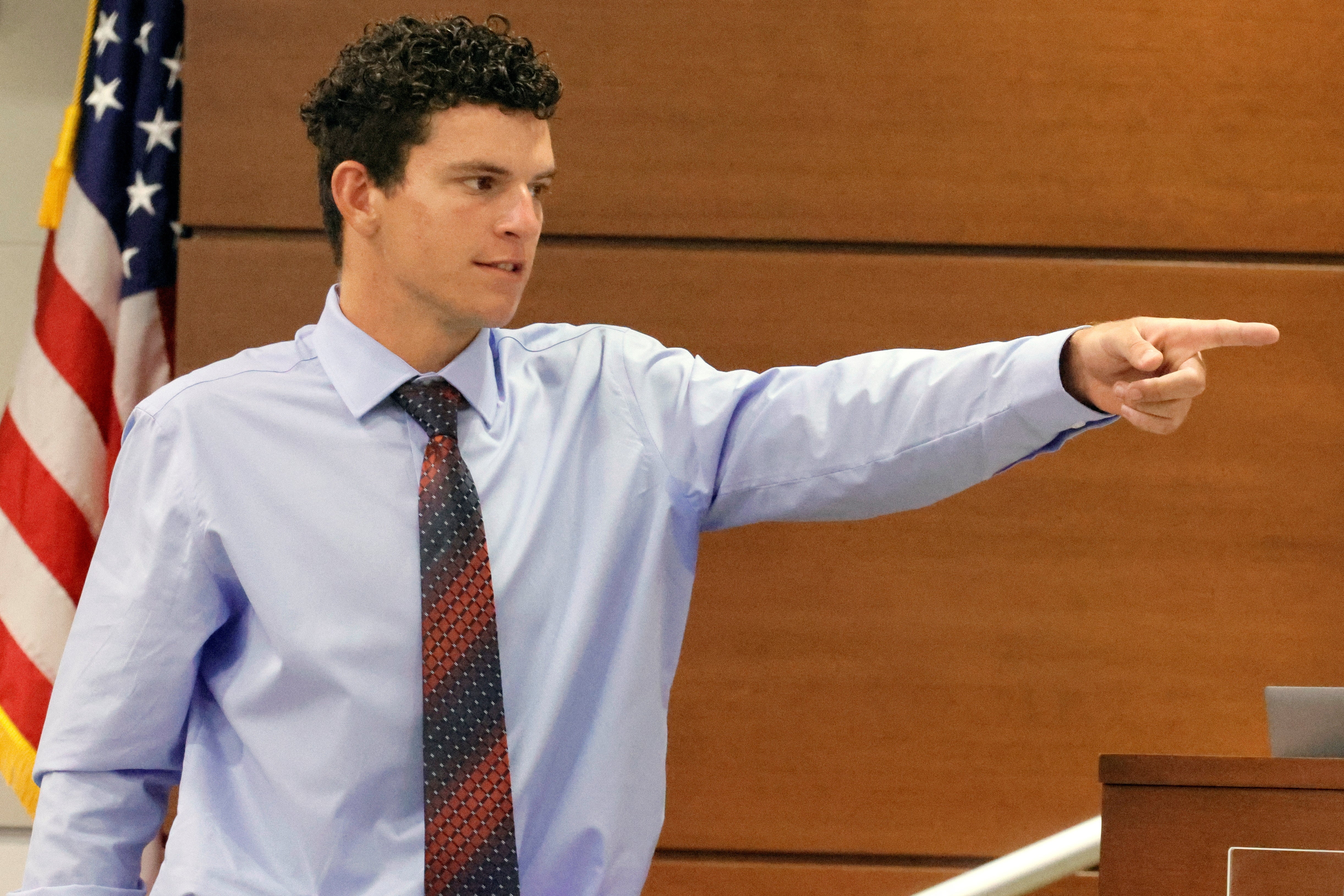
Survivors from another classroom also testified how they were in a Holocaust history lesson when Cruz began shooting through the door.
Teacher Ivy Schamis broke down in tears as she told the court how student Nick Dworet correctly answered a question seconds before he was shot dead.
“It was really seconds later that the barrel of that AR-15 just ambushed our classroom. It came right through that glass panel and was just shooting everywhere. It was very loud. Very frightening. I kept thinking about these kids who should not be experiencing this at all,” she testified.
Three students were wounded in her class and two were killed: Dworet and Helena Ramsay, both 17.
Footage shows Cruz in McDonald’s minutes after shooting
Chilling surveillance footage played in court captured how Cruz calmly carried on with his day moments after murdering 17 students and staff members.
Following the massacre, Cruz fled the school grounds by hiding in plain sight among the terrified students.
He then casually walked to a nearby Subway for a drink where he was captured on surveillance footage strolling up to the counter to buy a cherry and blue ice drink – just 25 minutes after he stopped shooting.
He then went to a nearby McDonald’s, where – unbeknown to both at the time – he sat directly opposite and chatted to the brother of one of the students he had just shot.
In surveillance footage from the McDonald’s, student John Wilford is seen entering the restaurant and sitting in a booth on his own. Minutes later, Cruz calmly strolls inside and sits in the same booth directly opposite Mr Wilford – despite there being several empty booths around them.
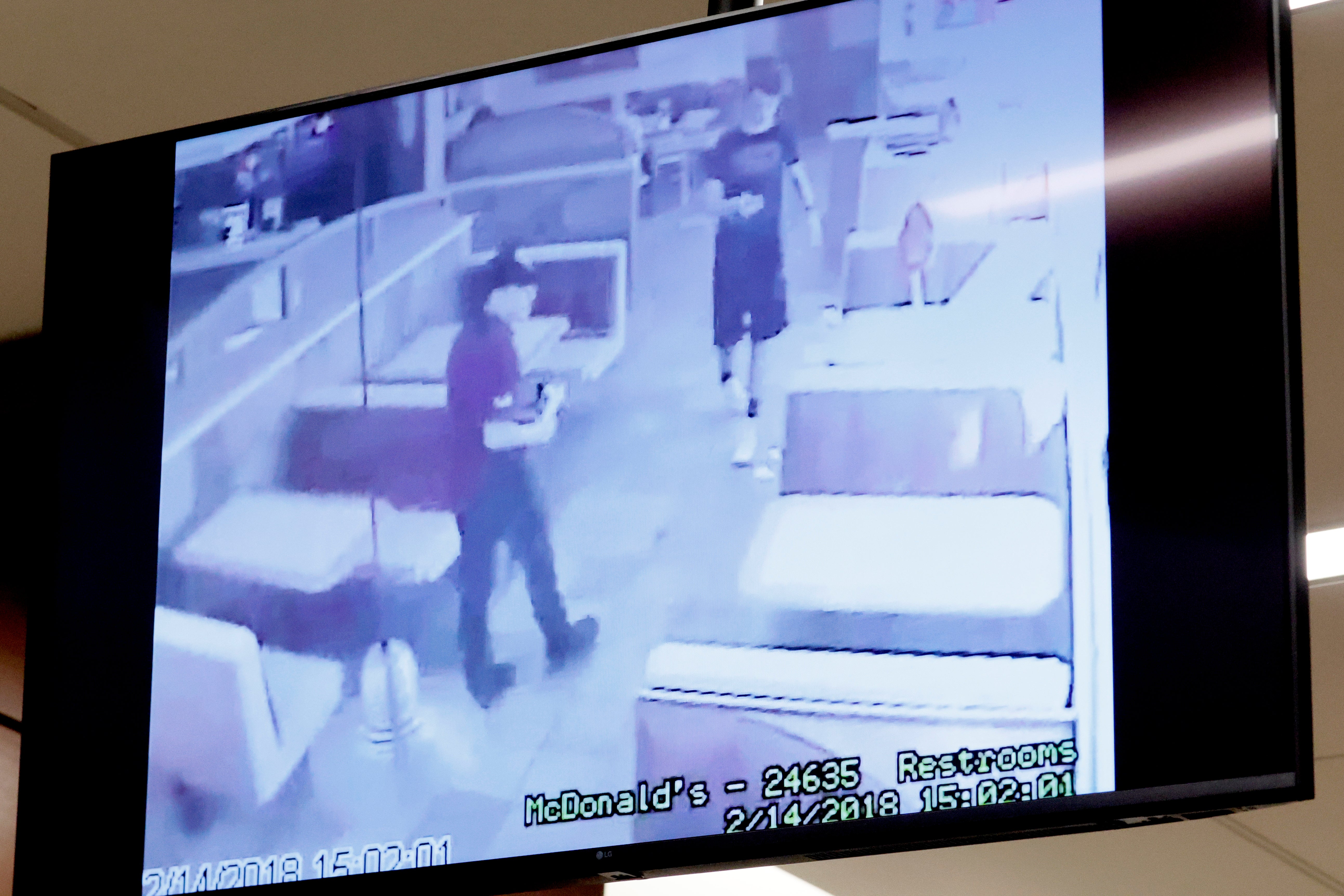
After a few moments, the two appear to exchange words.
Mr Wilford, who was in ninth grade at the time, testified that he had evacuated the school and arranged to meet his mother at the McDonald’s. They hadn’t been able to get in contact with his sister Madeleine Wilford.
He was waiting for his mother, when Cruz came and sat with him. He said he assumed Cruz was also a student at the school because he was wearing a Douglas JROTC shirt and had no idea that Cruz was responsible for the attack.
He said he started speaking to Cruz about what had happened but Cruz “didn’t really say much” and just sat with his “head down”.
When Mr Wilford went to leave, he said Cruz asked him for a ride but he told him no, because he was worried about his sister.
At the time, Madeleine was in grave condition after Cruz had shot her four times. She survived the attack.
Cruz was arrested around one hour after the massacre, when he was spotted by a police officer walking along a nearby road.
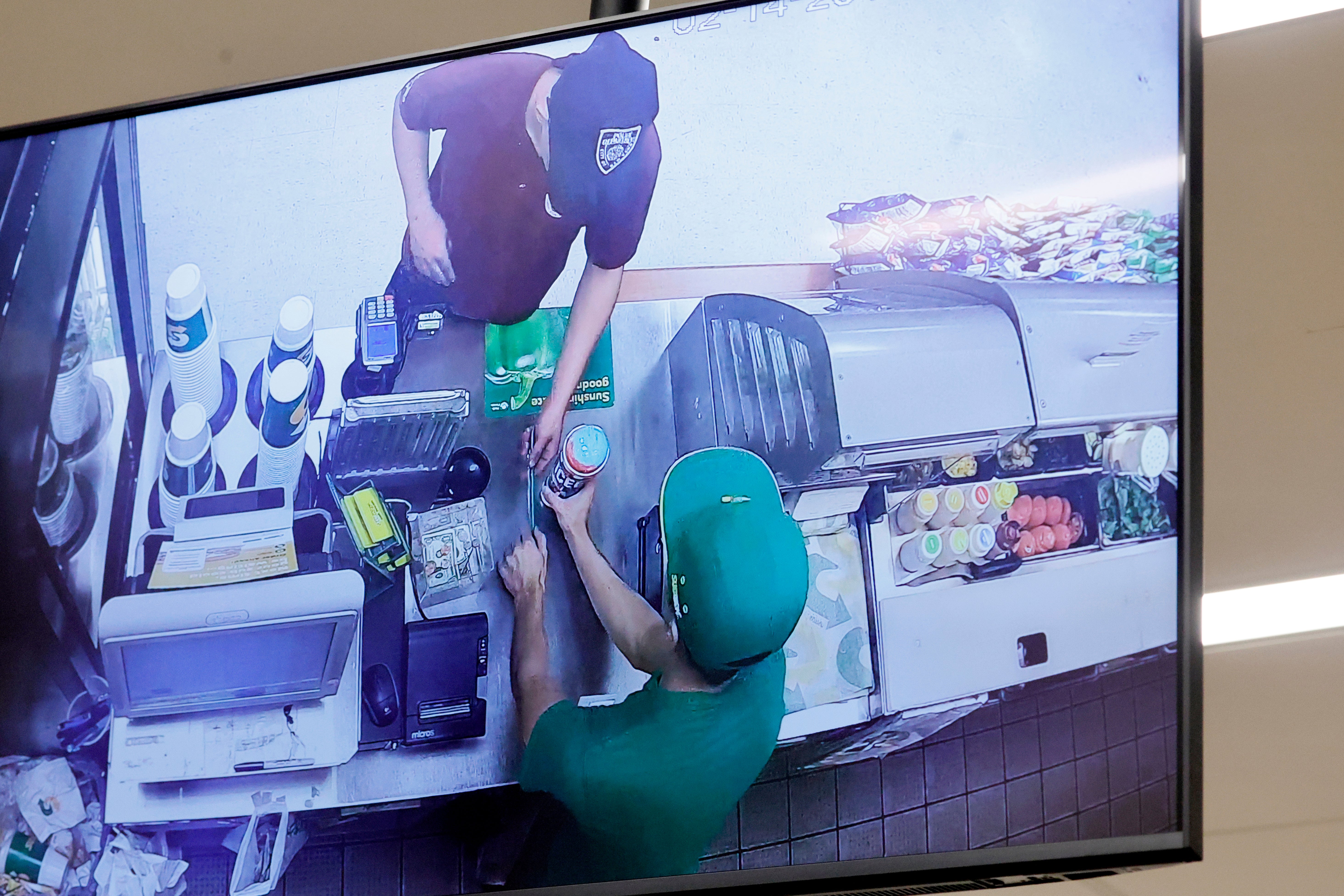
Jurors shown weapon used to murder 17
The AR-15-style rifle used by Cruz to murder 17 students and staff members was brought into the courtroom and shown to the jury.
Cruz fired more than 100 bullets in just seven minutes as he stalked the three floors of the freshman building, jurors heard.
He then left the black Smith & Wesson M&P 15 semi-automatic rifle on top of his tactical vest on the landing of the third-floor stairwell and fled the school.
Five gun magazines containing 160 bullets were left inside the vest.
Cruz also had a police ID card his late adoptive father Roger Cruz had been issued by a New York department.
Jurors also heard testimony from Michael Morrison, the owner of Sunrise Tactical Supply in Coral Springs, who sold Cruz the gun in February 2017 – one year before the massacre.
When the store owner asked Cruz what he was going to do with it, he said Cruz told him he planned to “go shooting with my friends during the weekend”.
He testified that he saw no red flags in his interactions with the then-18-year-old and Cruz’s firearms application was approved by Florida. In the aftermath of the massacre, the state raised the minimum age to legally purchase firearms from 18 to 21.
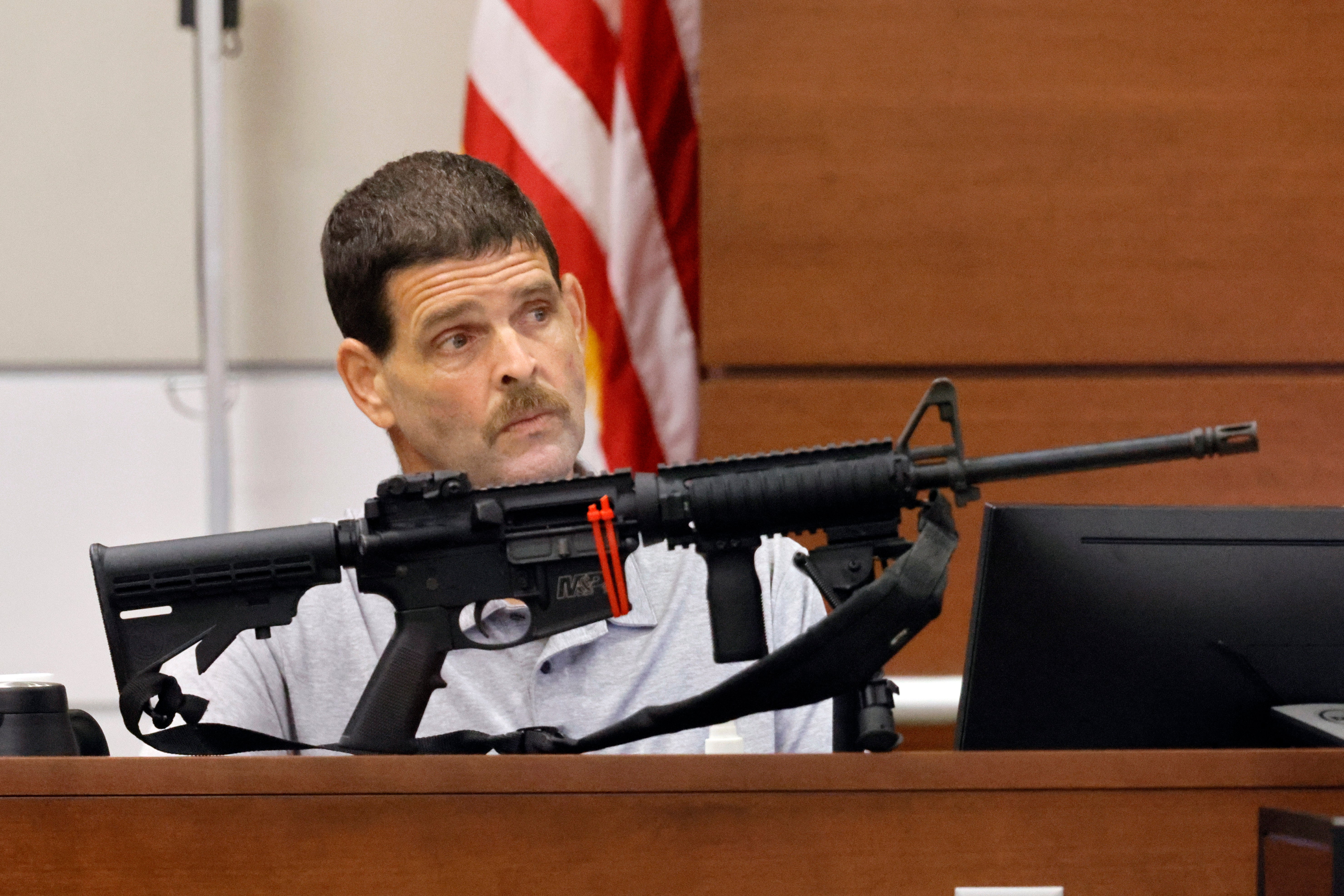
Graphic details of victims’ wounds revealed
Jurors were shown graphic crime scene and autopsy photos of Cruz’s victims.
Broward County Chief Medical Examiner Rebecca MacDougall, who performed autopsies on several of the victims, told jurors in distressing detail about the gunshot wounds sustained by Alex Schachter. The 14-year-old was one of the first to be killed in the massacre when Cruz shot through the window of his first-floor classroom, striking him with bullets while he was still sat at his desk.
One of the bullets entered Alex’s left chest, went through his lung and struck his spinal cord. He would have been left paralysed had he survived, she said.
The graphic testimony was difficult for victims’ family members sat in the gallery, with Alex’s grieving father seen covering his face and sobbing as he heard how his son died.
Dr Iouri Boiko, who carried out some of the other autopsies, detailed the horrific wounds suffered by Meadow Pollack, as she was shot seven times by Cruz while trying to hide in the alcove of a classroom on the third floor with Cara Loughran.
As well as the autopsy photos, jurors also heard harrowing testimony from law enforcement officers who found the bodies of students and staff on the scene that day and were also shown graphic crime scene photos taken by crime scene investigators with the Broward County Sheriff’s Office.
Sgt. Gloria Crespo took photos of the bodies of the five students and one teacher killed on the third floor, as Cruz gunned them down in the corridor at close range.
Shooter made chilling videos about plans for massacre
The gunman made three chilling cellphone videos in the days leading up to 14 February 2018, where he spoke of his plans to carry out the massacre and kill at least 20 people at his former school.
In the first, filmed six days before the attack, he says: “Today is the day. Today it all begins. The day of my massacre shall begin.”
In the second, he is heard saying: “When you see me on the news, you’ll all know who I am. You’re all going to die. ... Can’t wait.”
The final video, which was filmed three days before the massacre, shows Cruz speaking directly into the camera, saying that he is “going to be the next school shooter of 201” and making gunshot sounds.
In the 90 minutes before the shooting began, Cruz was also texting his ex-girlfriend, jurors heard.

He told her he loved her and asked if she wanted him to “go away”, to which she replied: “You’re scaring me and I want you to leave me alone.” He told her he loved her one more time before entering the school.
Text messages between the mass shooter and a friend were also shown in court. Cruz was messaging the friend during the day on 14 February 2018 asking them to find him a date with a girl for that night.
Just as Cruz’s Uber was pulling up at Marjory Stoneman for him to carry out the massacre, the friend texted him to say he had found him a date.
Cruz replied: “Too late man.” Three minutes later, he began opening fire on victims.
On the way to the school he also geared himself up for the shooting by listening to “Pumped Up Kicks” - a song about a school shooting - the court heard.
Victims’ families give heartbreaking impact statements
Family members of Cruz’s victims took the stand to give gut-wrenching victim impact statements as the prosecution rested its case.
In one heartbreaking moment, the son of Chris Hixon — the school’s athletic director and wrestling coach who died trying to save students — appeared alongside his mother to tell the jury about his father.
“I miss him,” Corey, who has special needs, said through tears before hugging his mother Debbi.
“Every Saturday we ran to Dunkin’ Donuts and walked back.”
The father of one of the other victims shouted with anger and grief as he took the stand to speak about life without his 14-year-old daughter Alyssa Alhadeff.
Dr Ilan Alhadeff told jurors about her “infectious laugh that I can only get to watch now on TikTok videos”.
“My first-born daughter, daddy’s girl was taken from me!” he shouted.
“I get to watch my friends, my neighbors, colleagues spend time enjoying their daughters, enjoying all the normal milestones, taking in the normal joys and I only get to watch videos or go to the cemetery to see my daughter.”
One of Alyssa’s two younger brothers was too young to understand her death when it happened, but now “asks to go see his sister at the cemetery from time to time”. “This is not normal!” said Dr Alhadeff.
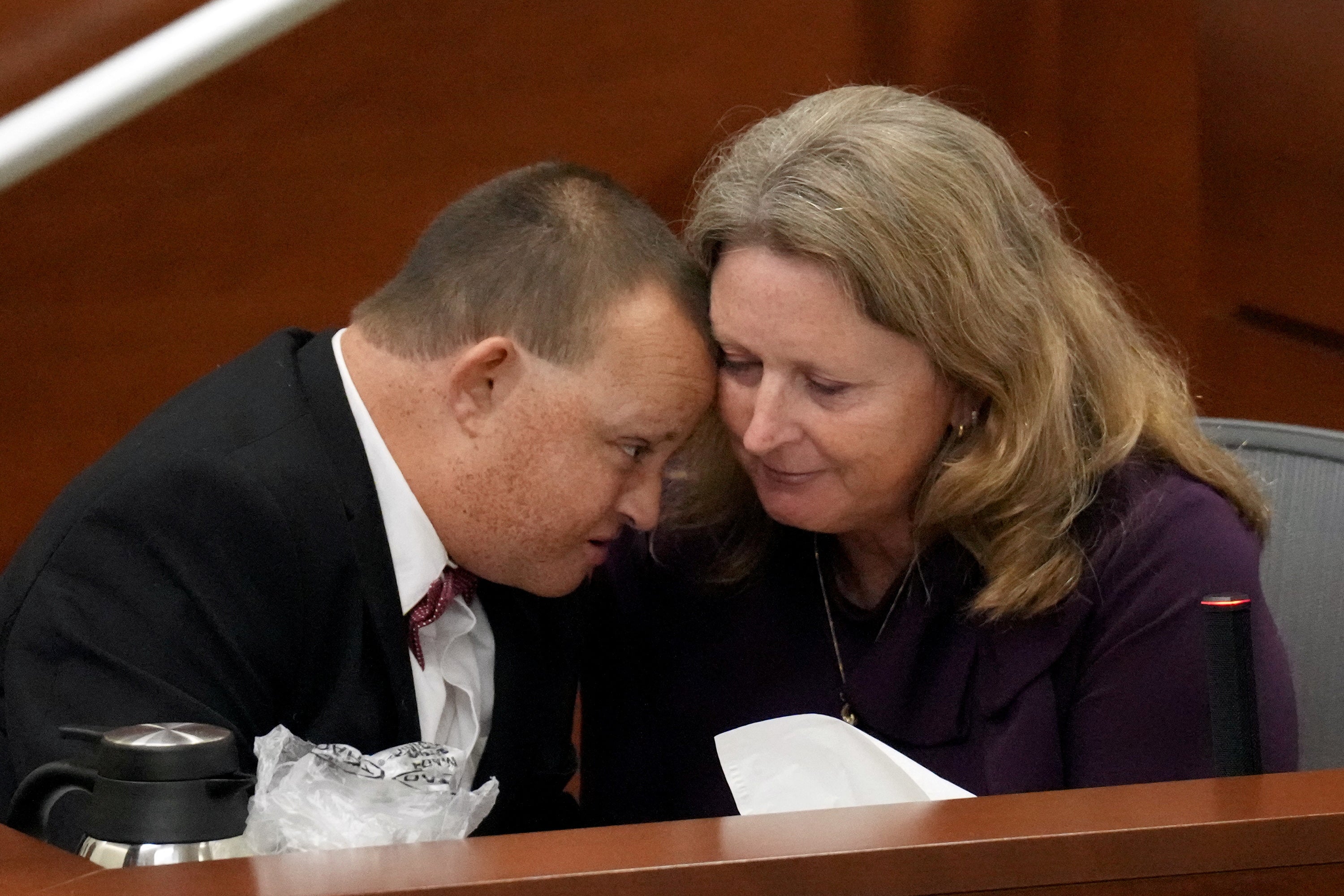
Jurors tour scene of massacre
At the end of the prosecution’s case, jurors were taken to the high school to tour the site of the massacre.
In the aftermath of the Valentine’s Day 2018 shooting, the 1200 freshman building was closed off and preserved exactly as it was that day.
The building still had blood on the floors, bullet holes in the walls and doors and Valentine’s Day gifts abandoned in the chaos.
The only thing removed from the scene in the wake of the shooting were the victims’ bodies and their personal items, such as school backpacks.
Judge Elizabeth Scherer told jurors that the visit would help them analyse the evidence presented in the trial. Local officials plan to tear down the school after the trial.
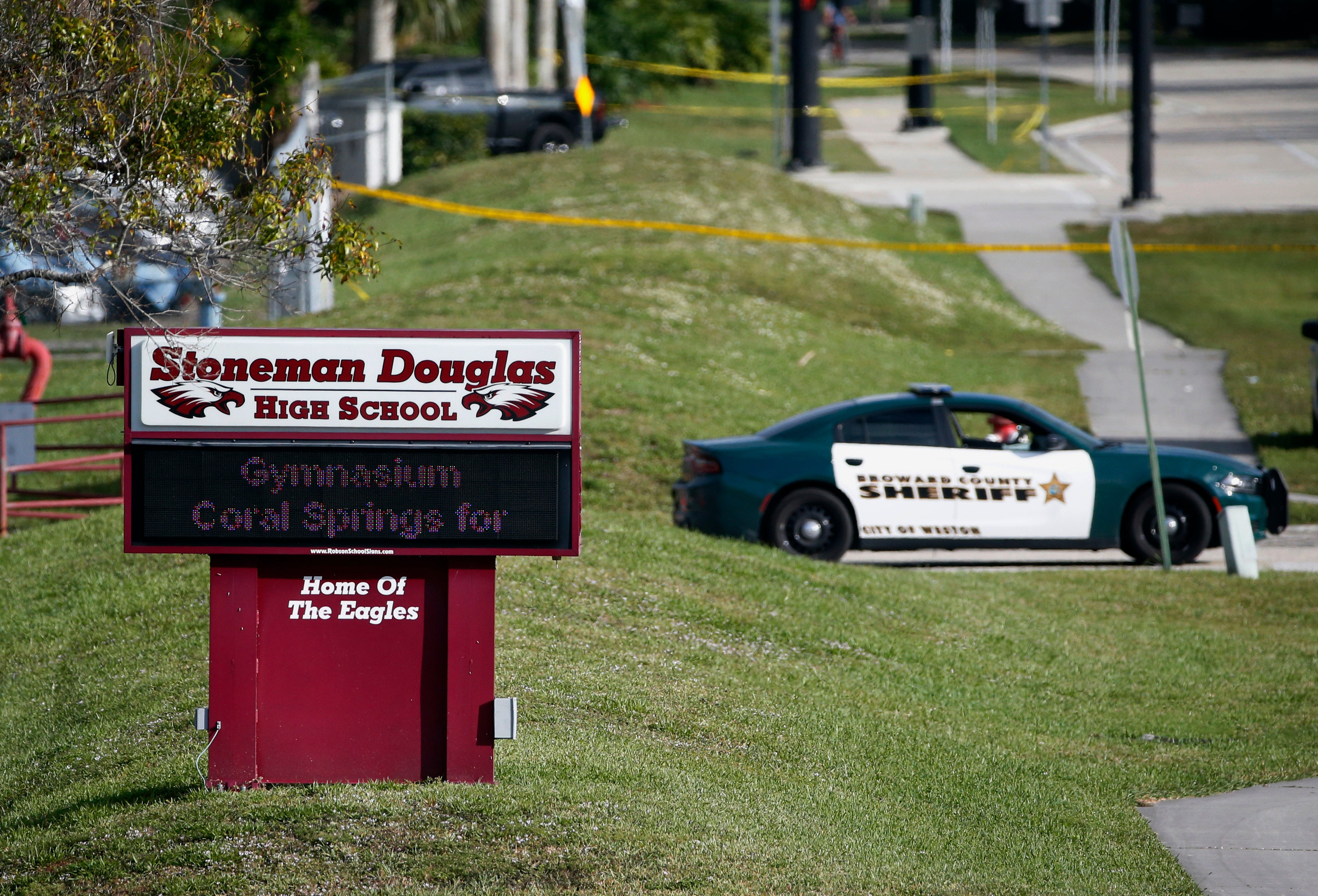
Court hears that biological mother ‘poisoned’ him in womb
The defence began its case by calling witnesses to testify that Cruz’s biological mother Brenda Woodard abused alcohol and drugs while pregnant – as his legal team seeks to argue that he suffers from fetal alcohol spectrum disorders (FASD).
Cruz’s biological half-sister Danielle Woodard testified that her brother was born from their mother’s “polluted womb”, telling jurors that she saw her mother smoke cigarettes, drink and smoke crack while pregnant with him.
The mass killer’s older sister was led into court in handcuffs as she awaits trial over an alleged carjacking of an elderly woman.
Woodard shares the same biological mother as Cruz but they did not grow up together as Cruz was adopted as a baby by Lynda and Roger Cruz while Woodard lived on and off with their mother.
In opening statements, Cruz’s attorney Melisa McNeill also spoke of his apparent FASD saying that his brain is “irretrievably broken” because his biological mother “poisoned him in the womb”.
“His brain is broken. He is a damaged human being,” said Ms McNeill.
She detailed how his mother – who put him up for adoption – was homeless, an alcoholic, drug addict and working as a prosititue when she fell pregnant with him. “His prenatal vitamins consisted of... Bum wine, crack cocaine and cigarettes,” she said.
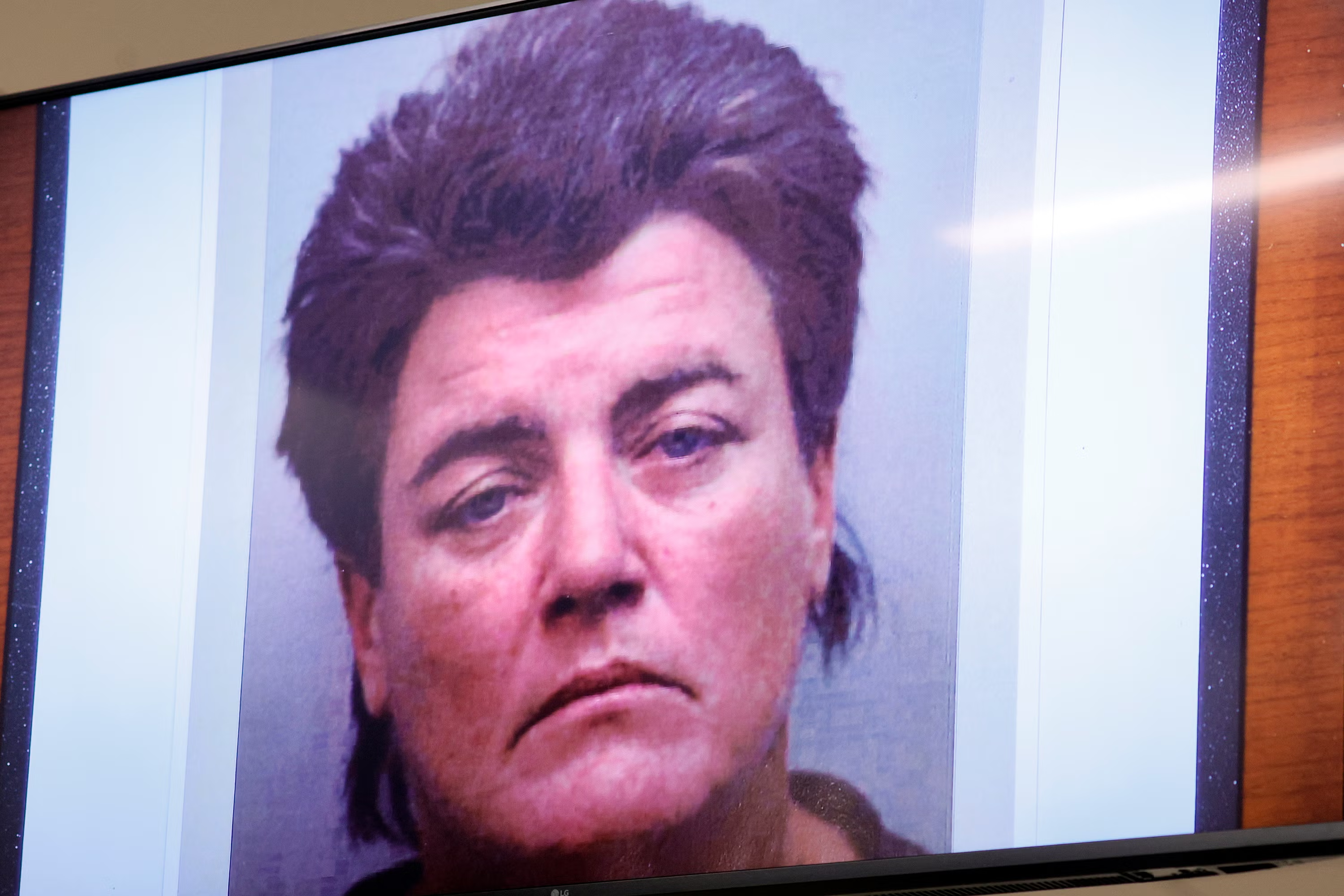
Shooter accused of ‘inappropriately touching’ young girl
Cruz was accused of “inappropriately touching” a young girl years before he carried out the high school massacre, jurors heard.
Finai Browd testified that she and Lynda Cruz became best friends when they both lived in New York in the 1980s. The friends then both moved to Florida with their husbands and deliberately lived near each other.
Around the same time that Lynda and Roger adopted Nikolas and then his biological half-brother Zachary, Ms Browd and her husband also adopted children.
Both of their families were very close and their children would spend a lot of time together, she said.
But, at one point, she said there was “an incident with Nikolas... inappropriate touching” of a young girl.
When questioned further about the incident under cross-examination, Ms Browd said that Cruz had “tried to put his hand in [the girl’s] shirt and “tried to watch her shower”. The girl was around six or seven years old at the time.
Cruz’s adoptive mother Lynda instantly put a stop to it, Ms Browd said. “Lynda had nipped it in the bud right away,” she said.
The former family friend said that Cruz was “aggressive” from a young age and had “tantrums” unlike those of a typical child, which meant other children “didn’t want to be around” him.
Cruz also had trouble eating and communicating and wore diapers until he was five years old, she testified.
Cruz watched his father die
Jurors heard how Cruz watched his adoptive father Roger die when he was just five years old, running and telling his mother “daddy’s dead”.
One day in August 2004, Roger was in the den of the family home with Nikolas and his younger brother Zachary while Lynda was in the kitchen making lunch, Ms Browd testified.
Suddenly, Nikolas – who was almost six at the time – ran past Lynda crying. When she asked her son if he was upset because his father had yelled at him, Cruz allegedly gave a harrowing response.
“As clear as sunshine he said, ‘No, Daddy is dead,’” said Ms Browd.
At that moment, she said Lynda told her she ran into the den and found her husband dead on the couch. He had suffered a heart attack.
After Roger’s death, Lynda was left to raise the two boys alone.
Ms Browd testified that Nikolas and Zachary went to a grief support group with other children after witnessing the traumatic incident. Jurors previously heard in courtroom testimony that Cruz was not given grief counseling until four years after Roger’s death.

Teachers warned he posed a danger
Several psychiatrists, neighbours and school staff testified about Cruz’s disturbing behaviour both in the home and at school growing up.
Jurors heard that from the age of three, Cruz was treated for a variety of diagnoses for developmental, mental health and behavioural issues. He moved across multiple schools – some general education and some for children with special needs.
Carrie Yon, Cruz’s eighth grade teacher at West Glades Middle School, presented her notes to the courtroom where she wrote that she feared he posed a risk to those around him years before the massacre.
“I strongly feel that Nikolas is a danger to the students and faculty at this school,” Ms Yon wrote on a close functional behaviour assessment form at the time, adding that “I do not feel that he understands the difference between his violent video games and reality”.
Jurors were also shown an essay assignment in which Cruz had detailed his plan to create a “sex boat” with crude drawings of stick figures with genitals. When she praised his work one time, he replied: “I’m a bad kid. I want to kill.”
Ms Yon wrote that Cruz needed to be in “a special school with smaller classrooms and locked doors”.
A functional behavioural assessment carried out by school staff and shown in court also revealed that Cruz asked in a lesson if people “ate” the bodies of dead people in the Civil War.
During the incident, dated 11 September 2013, Cruz also “became fixated on death and assassination of Abraham Lincoln” and asked what it sounded like when he was killed.
“Some questions he asked were ‘What did it sound like when Lincoln was shot? Did it go pop, pop, pop really fast? Was there blood everywhere? After the war, what did they do with all of the bodies? Did people eat them?’” he reportedly asked.
In another incident, Cruz also drew pictures of shooting victims and nude images of people. Staff at the school – which Cruz attended from 2011 to 2013 – also detailed that “Nikolas will find any excuse to bring up guns”.
Cruz had dreams of killing people
Jurors were also shown a letter sent from school therapists to Cruz’s psychiatrist Dr Brett Negin on 5 June 2014. At the time, Cruz was enrolled at Cross Creek School in Broward County, Florida, for children with behavioural challenges.
In the letter, they wrote that Cruz had “dreams of killing others and is covered in blood”. This was four years before he carried out the mass shooting. They also said that Cruz was “very irritable and reactive” both at home and at school, paranoid and had “a preoccupation with guns and the military and perseverates on this topic inappropriately”.
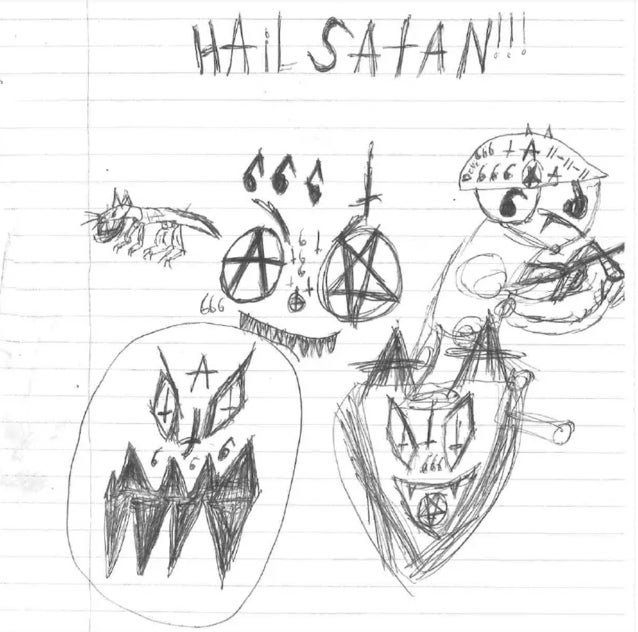
The letter also states that Cruz “punches holes in the walls” when upset. The school mental health experts said they though Dr Negin should “reassess” Cruz’s medication management. Dr Negin testified that he never received the letter.
He treated Cruz from January 2012 up until August 2017, diagnosing him with Disruptive Behaviour Disorder during that time.
Neighbour says Cruz went on toad ‘killing spree’
Paul Gold, a former neighbour of the Cruz family, testified that Cruz once went on a “killing spree” of all the toads in the neighbourhood when one of the family’s dogs died because it had eaten a toad.
“He tried to kill every toad in the neighbourhood,” he said.
Mr Gold lived next door to the Cruz family in Parkland from 2008 to 2011 and stayed in contact with them even after moving out of the neighobourhood.
He testified that Cruz would have “episodes” where he would “lose his temper and break things and seem out of his mind”, saying that it seemed “almost like it was another person who had done it”.
Lynda Cruz confided in him that she was “scared” of her son, he said.
“She told me she was scared of him,” he testified. “She told me not to believe the nice appearance he had and angelic ways and that he would turn and do bad things. And she was a little afraid of him at some times.”
When Lynda died in November 2017, Mr Gold testified that Cruz was “very upset” that only five people had shown up for her funeral.
Cruz and Zachary initially moved in with Mr Gold’s ex-partner Rocxanne Deschamps but Cruz had to leave the home just one month later after the police were called over an alleged fight with Ms Deschamps’ son.
Three months after Lynda’s death, Cruz carried out the massacre.
Under cross-examination, Mr Gold was grilled about jailhouse phone calls with Cruz where they discussed making a movie about the mass murderer’s life.
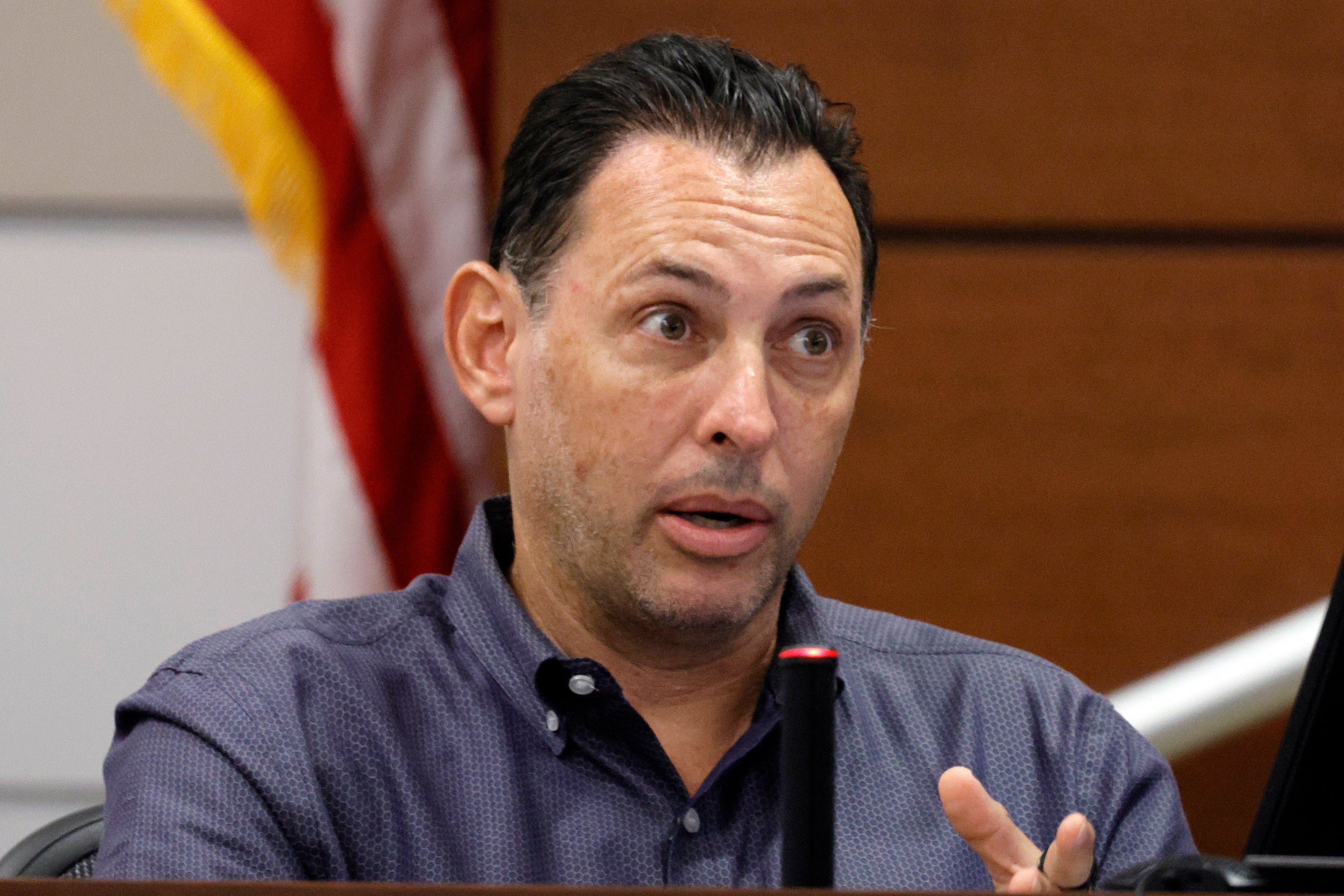
Cruz didn’t have consistent treatment
Psychologist Frederick Kravitz, who treated Cruz when he was eight, testified that the future mass shooter didn’t have consistent treatment.
He said that Cruz had many behavioural and developmental issues but Lynda was not consistent with getting him treatment. While he recommended Cruz should attend weekly sessions, Lynda only brought him in 15 times over a 13-month period, he said.
The psychologist said that Lynda appeared to be depressed from her husband’s death and was overwhelmed trying to deal with her two “tumultuous” sons.
In other witness testimony, jurors were shown a form completed by Lynda her son’s behaviour.
In it, she said that she believed “something is very wrong with him” beyond his ADHD diagnosis.
Lynda detailed that he had “frequent anger outbursts” where he would start “screaming, kicking, throwing things and punching holes in the wall”. His temper would often start when he was playing Xbox, she said, because Cruz was a “sore loser” and had “low self-esteem”
Jurors heard how Lynda often called the police to the family home for both Cruz and Zachary’s behaviours.
Case manager Tiffany Forrest testified that there was “quite a bit of dysfunction” in the family home and that Cruz’s younger brother Zachary bullied him. She also said that Cruz’s mother used to sleep clutching her purse because she feared her sons were going to steal it.
FASD expert ‘never seen’ so much prenatal alcohol exposure
Dr Kenneth Jones, one of the nation’s leading experts in fetal alcohol spectrum disorders (FASD), testified that he has “never seen” a woman abuse alcohol while pregnant as much as Cruz’s biological mother.
“I don’t think I have ever seen — I know I have never seen — so much alcohol consumed by a pregnant woman,” he said, saying that he has worked with more than 1,000 people exposed to alcohol in the womb during his 50-year career.
He went on to say that Cruz “without any question” fulfils the criteria of someone with an FASD, saying that his assessment found that he has alcohol-related neurodevelopmental disorder (ARND).
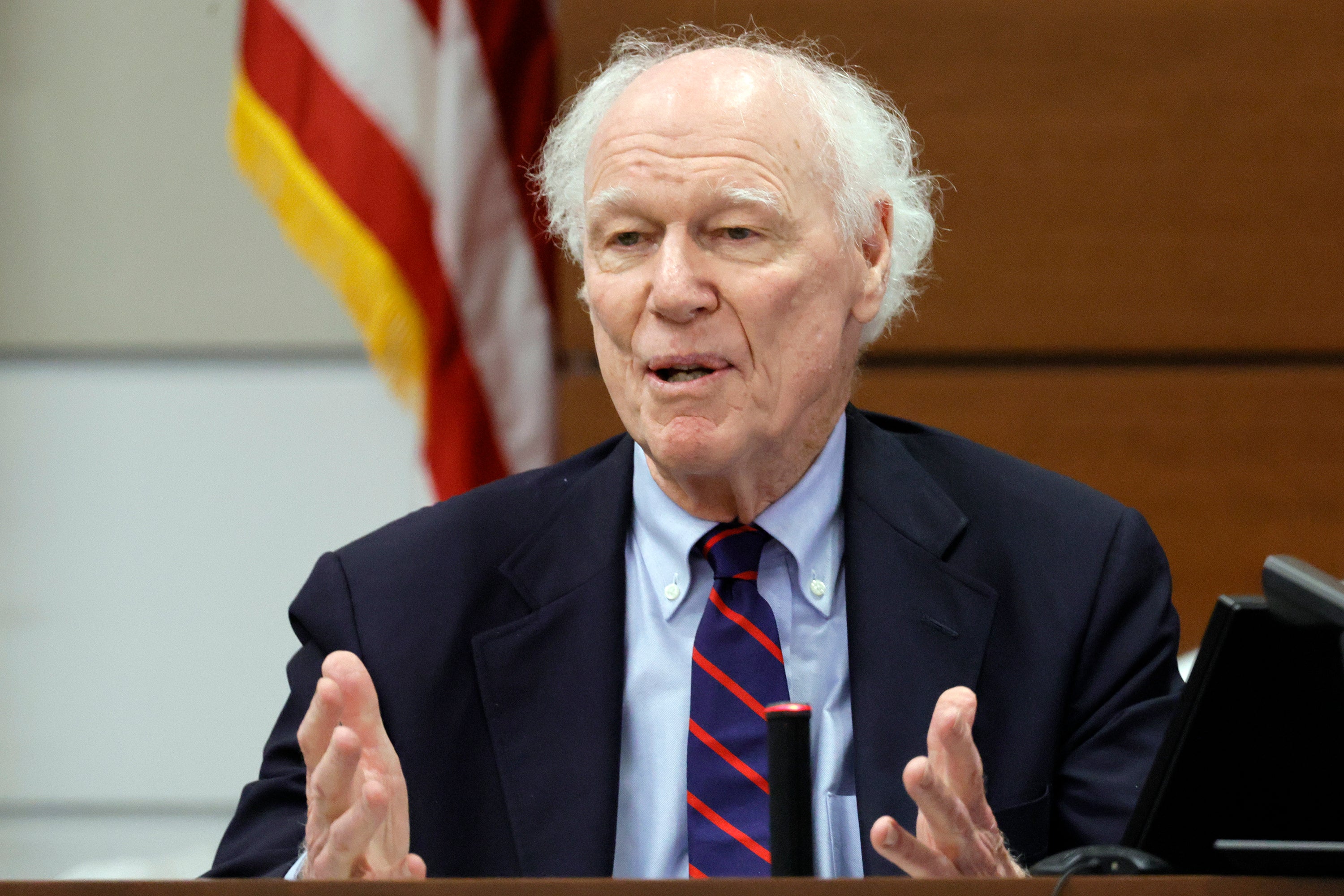
In a startling statement, Dr Jones testified that FASD can “in and of itself cause people to commit murder”.
Under cross-examination, Dr Jones was asked about evidence that shows Cruz planned the Valentine’s Day 2018 massacre and whether that contradicts the behaviours of someone with FASD.
Dr Jones confirmed to lead prosecutor Mike Satz that someone with FASD struggles with planning and organisation. Mr Satz then went on to detail the research and planning that Cruz carried out in the months leading up to the mass shooting, including various internet searches about other massacres.
His testimony came on the heels of another FASD expert – Dr Paul Connor – who said that he carried out neuropsychological testing on Cruz and found that he had deficits in nine out of 11 domains in the assessment. An individual with deficits in three or more domains is consistent with having an FASD, he said.
Cruz online searches for Nazi items and nude “little girls’
The prosecution began its rebuttal by calling witnesses to testify to Cruz’s use of swastikas.
Detective Nicholas Masters testified about Cruz’s online search history and internet activity prior to the 2018 massacre. Jurors were shown searches for Nazi paraphernalia and Hitler’s birthday as well as for child porn, with searches including “little girls naked in shower” and “little girl p***ies”.
Cruz also used racist language online and spoke of his desire to kill Black people.
Jurors were also shown photos of the military-style boots Cruz wore to carry out his attack and the 30-capacity magazine left behind at the scene – both of which had swastika scratched onto them.
The court was also shown a trove of disturbing notes found in Cruz’s jail cell ahead of his trial, including sketches where he recreated the 2018 massacre and notes saying he enjoyed causing “pain and death”. A photo of his cell wall also revealed he had written “666” using his own hemorrhoids blood.
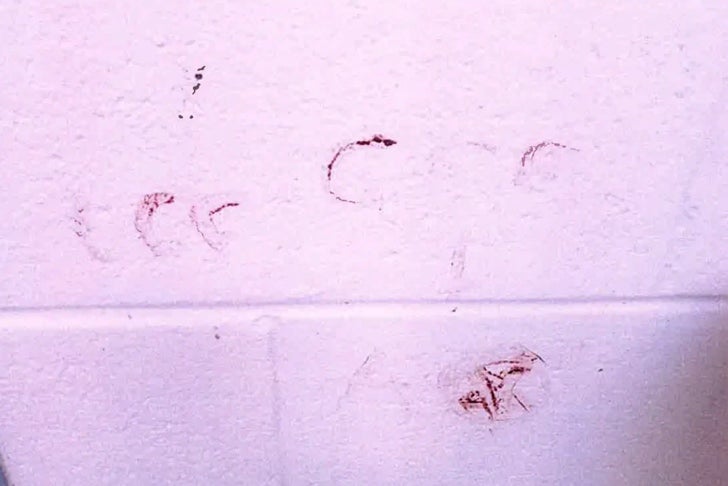
Forensic Psychiatrist Dr Charles L Scott then gave extensive testimony, detailing how – after spending up to 500 hours on the case and interviewing Cruz over three full days in March 2022 – he had diagnosed him with antisocial personality disorder, commonly known as sociopathy.
Video footage from their interviews was played in court, showing Cruz describing how he began killing animals from a young age, skinning and burning lizards alive aged just four years old.
The psychiatrist also said that he found “robust” evidence of Cruz malingering, as a video clip showed the killer claiming that he only used swastikas “for attention” and believes they are symbols of “peace”.
Cruz ‘studied’ other mass shootings and planned massacre for years
In his interviews with Dr Scott, Cruz revealed how he thought about carrying out a mass shooting for many years and “studied” the Columbine and Virginia Tech massacres in preparation for his own.
Cruz said that he first started thinking about mass shootings from the age of 13 or 14.
Leading up to the massacre, he said he conducted “research” into several other mass shootings, saying he learned from other killers the type of gun to use and what to expect during the massacre.
“I did my own research. I looked up on Wikipedia, I studied mass murderers and how they did it,” he said nonchalantly. “Their plan and what they got and what they used.”
Cruz also spoke of his preparations the night before the massacre which included him practicing the shooting in a backyard and planning to wear his Marjory Stoneman Douglas High School JRTOC polo shirt as a “disguise”
Dr Scott testified that Cruz planned the attack and showed that he has adequate executive functioning – the mental processes that enable people to plan and control his behaviour when he wants.
His examination of Cruz led him to diagnose him with antisocial personality disorder, borderline personality disorder, a history of conduct disorder and malingering – refuting the defence’s FASD argument.
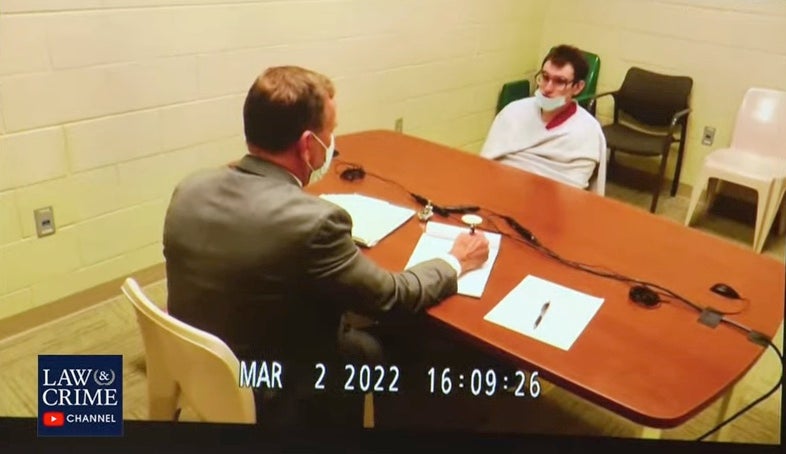
Cruz tells psychiatrist chilling reason mass shooting ended
Nikolas Cruz has revealed that the mass shooting at Marjory Stoneman Douglas High School only came to an end because he “couldn’t find” any more victims as he tried to claim that he “showed mercy” before killing them.
“I couldn’t find anyone to kill,” came his harrowing response.
Cruz had told Dr Scott how he tried to shoot through the windows of the freshman building and smash the glass so that he could open fire on the crowds of terrified students evacuating the school.
But, he was unable to break through the glass so put down his AR-15 and left the building.
In the interview footage, Cruz is seen calmly giving graphic details of how he murdered 17 students and staff at the high school.
Cruz claimed that he “showed mercy” to two of his victims – before slaughtering them with his assault rifle because they gave him a “nasty look”.
“I think I showed mercy to those two girls,” the killer told Dr Scott.
He added: “I was thinking about shooting them but I didn’t want to do it so was going to walk away down the hallway... But they gave me a nasty look.”
Cruz also spoke matter of factly about his gruesome slayings of his victims, nonchalantly telling Dr Scott how he watched the head of one victim “blew up like a water balloon”.
Jurors see videos Cruz made days before massacre
Jurors were shown videos Cruz made in the days before the massacre, where he told viewers his plans.
“With the power of my AR you will know who I am,” he says in one video.
“My goal is 20 people, my location is Stoneman Douglas in Parkland, Florida. It’s going to be a big event,” he says.
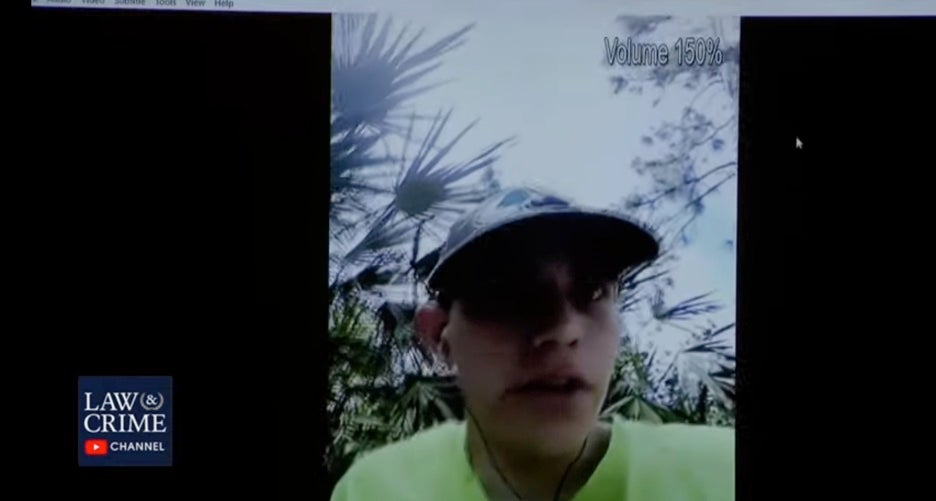
“When you see me on the news you’ll all know who I am,” Cruz says, breaking into a smile and laugh.
Dr Scott testified that Cruz is “calm, organised, speaking slowly” in the videos, saying it is more evidence of Cruz’s planning. “This was not a spur of the moment decision. This had been planned out for months,” said Dr Scott.




